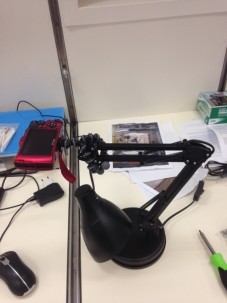Doing Science When There’s No Science to Be Done
With an abundance of time and a dearth of work, we have begun to devise ways of doing science before we can actually do science at sea. Among other things, we set up an imaging system to take pictures of particle filters we bring back from the deep sea.
By Frankie Pavia
Six days after we were supposed to have departed, the UltraPac scientists and ship’s crew remain stranded at port aboard the FS Sonne. Containers with the last of our missing science gear are on a truck driving up from San Antonio, Chile, where the port felt comfortable unloading our acids and radioisotopes. The Sonne’s spare parts are being unloaded from a ship across the harbor that I can see from my cabin’s windows. With an abundance of time and a dearth of work, we have begun to devise ways of doing science before we can actually do science at sea.

We first discussed how to optimize our sample depth selections. In the first three stations, the deep waters will be downwind of the East Pacific Rise, one of the fastest spreading mid-ocean ridges in the world. At ridge axes, water that has percolated through the ocean crust and weathered mantle-derived rocks is erupted back out by volcanism and hydrothermal vents. This ‘plume water’ bears a distinct signature of the Earth’s mantle—high in rare noble gases like 3He, biologically critical trace metals like iron and manganese, and small particles that are reactive sites for removing other elements like phosphorous, magnesium, and most importantly (for me!), protactinium and thorium.
When this plume water enters the ocean, it is very hot and less dense than the surrounding waters. It rises until it attains a state of neutral buoyancy—when its density is the same as ambient seawater. Then it simply moves and acts like any other water—in currents and eddies. But since it bears distinct chemical signatures, chemical oceanographers can find easily find it—after they’ve measured something in it.
But we want to know where it is before we sample it. We want to understand the processes going on inside the plume. What kind of particles are there? How fast do they remove trace metals from the ocean? How much iron enters the ocean from submarine volcanism? If we are to answer these questions, we must first be able to sample exactly within the plume waters—which means we must know where they are before we deploy our bottles.
Luckily, past cruises from the World Ocean Circulation Experiment (WOCE) have measured helium isotopes and density in the Pacific before. As a result, we know roughly what density surface is associated with the neutrally-buoyant plume waters. When we sample, we will send down a line with a CTD sensor to measure temperature, salinity, and pressure, from which we can calculate density. That line will have our bottles on it. We can instantaneously calculate the density of the waters we are sampling, find the depth of the density surface we know is associated with plume waters, then tell our bottles to open and sample at that depth. Problem solved!
We also set up an imaging system to take pictures of the particle filters we bring back. At seven depths of each station, we will deploy in-situ pumps that filter thousands of liters of seawater through a filter at a given depth. We then haul the pumps back to the surface, remove the filters, and analyze them.
We would like to photograph the filters before we analyze them so we can visually assess how much material there is on each filter, to confirm the results from our chemistry. To do this accurately, we must photograph every filter from the same angle, with the same lighting, with the same shutter speed. We went to a hardware store in town yesterday and bought some supplies, not knowing if the imagined setup would actually work.
It worked! We turned a lamp with a flexible stand for adjusting light height into a camera holder, decapitating the lamp portion and replacing it with a tripod holding the camera. Then we installed software allowing the camera to be controlled from a phone, so we could take pictures and adjust shutter speed remotely. We bought a clip-on lamp that will be attached to the camera holder for constant lighting (this one used for its true purpose!).
We are finally scheduled to receive our last missing container and depart port late tonight, around 22:00. While the delay has been frustrating, I suppose it hasn’t been all bad. We were scheduled to leave December 17, the day before the new Star Wars movie came out. Six extra days in port meant we were able to go into town to watch it. It was our last little leisure activity on land. Now it’s time for the ocean.
